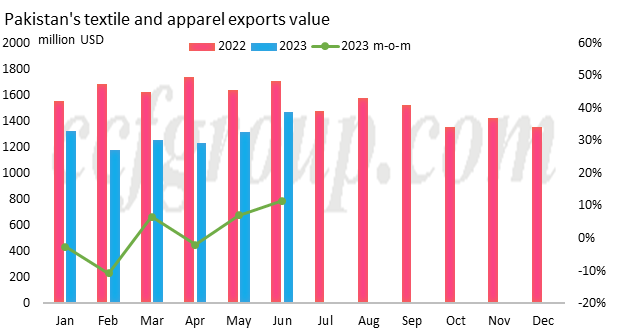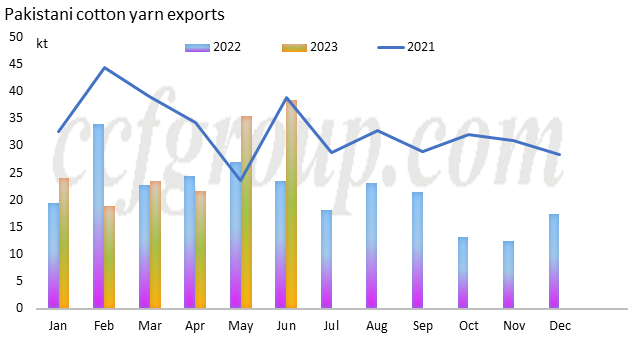Pakistan textile industry receives $6 billion aid to struggle onwards
1. From January to June 2023, Pakistan's textile and apparel exports amounted to $7.785 billion, a decrease of over 20%.
Recently, it is reported that Pakistan has received successive injections of $2 billion from Saudi Arabia and $1 billion from the United Arab Emirates. In addition, with the approval of a $3 billion standby fund from the International Monetary Fund (IMF), its foreign exchange reserves are expected to rise to $15 billion. The short-term debt crisis seems to have been somewhat relieved, but the government has had to accept the IMF's conditions, including reducing subsidies to the domestic power sector. Currently, Pakistan has once again increased its electricity prices by 4.96 rupees/kWh to 29.78 rupees/kWh (equivalent to approximately 0.753 yuan/ kWh), making the prospects for subsequent industrial and commercial recovery in Pakistan more challenging.

As one of Pakistan's pillar industries, the textile sector has been contributing significantly to the country's foreign exchange earnings, with textile exports exceeding $1 billion per month in the first half of this year. In June 2023, textile and garment exports reached $1.472 billion, hitting a new high for the first half of the year. However, compared to the same period last year, it still remain considerably lower. In cumulative terms, from January to June 2023, Pakistan's textile and apparel exports totaled approximately $7.785 billion, marking a decline of $2.165 billion compared to the first half of the previous year, which signifies a decrease of over 20% in textile and textile and apparel exports.
2. The value added in Pakistan's textile exports remains relatively low.
![9]UHU~DO)}BONYL[TRW0ELR.png 9]UHU~DO)}BONYL[TRW0ELR.png](https://pic.ccf.com.cn/2023/07/20230725041138904.png)
In terms of specific export categories, Pakistan's textile exports still focus mainly on primary processing and mid-to-low-end textile consumer goods. From January to June 2023, the top five export products were: knitwear ($1.972 billion), ready-made garments ($1.66 billion), bed wear ($1.264 billion), cotton cloth ($956 million), and cotton yarn ($463 million). The total proportion of clothing exports accounted for approximately 46.6%, which is still significantly lower than the international standard of 60%. Additionally, Pakistan's outdated cotton planting technology and production processes make it difficult for the country to meet the production requirements of the high-end market. There is a long way to go for the textile industry to achieve product iteration and upgrading in the future.

Comparatively, the export of textile intermediates, such as cotton yarn, has been relatively robust. In Jun, Pakistan's cotton yarn exports reached 38,000 tons, and exports to China accounts for around 50-60%. Considering the current market situation, Pakistani siro-spun yarn inventory in Chinese domestic markets is large, which puts pressure on selling, particularly during the off-season, there is a common trend of price reduction in order to stimulate sales. Therefore, the sustainability of future demand for Pakistani cotton yarn remains uncertain.
3. In the first half of 2023, Pakistani textile and apparel imports amounted to $1.626 billion, a decrease of 1/3 year-on-year.
Due to the limited foreign exchange reserves, Pakistan's textile and apparel import has remained sluggish in the first half of this year. In June, the import value of textile and apparel was only $200 million, with a monthly average import value of around $271 million for the first half of 2023, which represents a 1/3 decrease compared to the monthly average import value in the first half of the 2022. However, the recent development is that the State Bank of Pakistan has lifted all import restrictions to meet the requirements for disbursement of IMF loans, which will provide relatively loose conditions for import settlement transactions in the future.
![))D(U3}2@05O%RT%@%)]M4R.png ))D(U3}2@05O%RT%@%)]M4R.png](https://pic.ccf.com.cn/2023/07/20230725041201919.png)
In summary, in the first half of this year, with developed economies like Europe and the US maintaining high interest rates, the international demand for textile end-products has been suppressed, and almost all major textile countries in East Asia and Central Asia have faced a decline in export volumes. However, since the second quarter, there have been signs of export recovery in Pakistan, Vietnam, India, and other regions. For Pakistan's textile industry, although the difficulty of purchasing cotton imports has alleviated, the domestic manufacturing capabilities in the textile sector are relatively weak. Additionally, high costs of electricity, natural gas, and financing pose challenges in the market competition faced by the industry.
- Top keywords
- Cotton Price
- Cotton Futures Price
- Cotton Futures
- CZCE
- PTA Futures Price
- Chemical Fiber
- Polyester Prices
- Wool price
- PTA Futures
- Shengze Silk
- China
- Yarn Price
- price
- China Textile City
- Fibre Price
- Benzene Price
- Cotton
- Index
- Cotton Index
- PTA
- fabric price
- NYMEX
- Top 10
- textile industry
- Spot Cotton
- Cotton Yarn
- Polyester Price
- Futures
- PTA Price
- cotton yarn price

